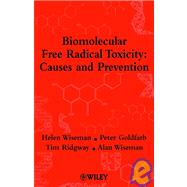
Note: Supplemental materials are not guaranteed with Rental or Used book purchases.
Purchase Benefits
What is included with this book?
Helen Wiseman is Lecturer in Nutritional Sciences in the Diabetes and Nutritional Sciences Division at King's College London.
Peter Goldfarb is professor of molecular biology at the School of Biosciences and Medicine, University of Surrey. His research interests include Molecular Toxicology and Pharmacogenetics.
Tim Ridgway is the author of Biomolecular Free Radical Toxicity: Causes and Prevention, published by Wiley.
Alan Wiseman is the author of Biomolecular Free Radical Toxicity: Causes and Prevention, published by Wiley.
| Preface | ix | ||||
| MACROMOLECULAR MECHANISMS OF INJURY AND THE ROLE OF ANTIOXIDANTS | 1 | (100) | |||
|
3 | (44) | |||
|
|||||
|
|||||
|
3 | (1) | |||
|
4 | (2) | |||
|
6 | (1) | |||
|
7 | (15) | |||
|
22 | (2) | |||
|
24 | (5) | |||
|
29 | (6) | |||
|
35 | (1) | |||
|
36 | (11) | |||
|
47 | (26) | |||
|
|||||
|
47 | (3) | |||
|
50 | (1) | |||
|
51 | (2) | |||
|
53 | (2) | |||
|
55 | (3) | |||
|
58 | (5) | |||
|
63 | (10) | |||
|
73 | (28) | |||
|
|||||
|
|||||
|
73 | (7) | |||
|
80 | (8) | |||
|
88 | (4) | |||
|
92 | (9) | |||
| GENE EXPRESSION AND CELL MEDIATED MECHANISMS OF TOXICITY EXPRESSION | 101 | (68) | |||
|
103 | (42) | |||
|
|||||
|
104 | (1) | |||
|
104 | (7) | |||
|
111 | (2) | |||
|
113 | (3) | |||
|
116 | (3) | |||
|
119 | (1) | |||
|
119 | (12) | |||
|
131 | (3) | |||
|
134 | (1) | |||
|
135 | (10) | |||
|
145 | (24) | |||
|
|||||
|
|||||
|
|||||
|
145 | (1) | |||
|
146 | (2) | |||
|
148 | (2) | |||
|
150 | (2) | |||
|
152 | (1) | |||
|
153 | (3) | |||
|
156 | (2) | |||
|
158 | (1) | |||
|
159 | (1) | |||
|
160 | (9) | |||
| HUMAN AND ENVIRONMENTAL HEALTH EFFECTS | 169 | (64) | |||
|
171 | (38) | |||
|
|||||
|
171 | (1) | |||
|
172 | (4) | |||
|
176 | (1) | |||
|
177 | (2) | |||
|
179 | (1) | |||
|
180 | (5) | |||
|
185 | (1) | |||
|
185 | (5) | |||
|
190 | (5) | |||
|
195 | (2) | |||
|
197 | (2) | |||
|
199 | (10) | |||
|
209 | (24) | |||
|
|||||
|
|||||
|
209 | (5) | |||
|
214 | (1) | |||
|
215 | (1) | |||
|
215 | (1) | |||
|
216 | (1) | |||
|
217 | (5) | |||
|
222 | (1) | |||
|
223 | (1) | |||
|
224 | (1) | |||
|
225 | (1) | |||
|
225 | (2) | |||
|
227 | (6) | |||
| Index | 233 |
The New copy of this book will include any supplemental materials advertised. Please check the title of the book to determine if it should include any access cards, study guides, lab manuals, CDs, etc.
The Used, Rental and eBook copies of this book are not guaranteed to include any supplemental materials. Typically, only the book itself is included. This is true even if the title states it includes any access cards, study guides, lab manuals, CDs, etc.